View in other NatureServe Network Field Guides
NatureServe
Montana
Utah
Wyoming
Idaho
Wisconsin
British Columbia
South Carolina
Yukon
California
New York
Lewis' Monkeyflower - Mimulus lewisii
Other Names:
Erythranthe lewisii
Native Species
Global Rank:
G5
State Rank:
S4
C-value:
7
Agency Status
USFWS:
USFS:
BLM:
External Links
General Description
PLANTS: A rhizomatous perennial that has erect, simple stems and grows from 15 to 70 cm tall. Plants may have sparse hairs or be glandular-pubescent. Source: Lesica et al. 2012.
LEAVES: Stem leaves are opposite, 1-7cm long, and lack or nearly lack petioles (sessile to subsessile). The simple blades are lanceolate to ovate blades with toothed (serrate) margins. Source: Lesica et al. 2012.
INFLORESCENCE: Showy pink-purple or magenta flowers that grow on 3-8 cm long stems (pedicels) that arise from the upper leaf axils. The tube is yellow with a purple-spotted palate. Sources: Giblin et al. [eds.] 2018; Lesica et al. 2012.
The specific epithet lewisii is in honor of the early North American explorer Meriwether Lewis who collected and documented Mimulus lewisii on his iconic expeditions across the American West. Mimulus is derived from the Latin word mime, meaning “actor” or “mimic,” and the male diminutive -ulus (Merriam-Webster 2019). This is most likely referring to the mask-like appearance of the flowers.
Phenology
Lewis’ Monkeyflower flowers from June through August (Fraga in Jepson Flora Project 2018).
Diagnostic Characteristics
Montana has 5 native
Mimulus species with purplish flowers, of which 2 are perennial and 3 are annual plants. In Montana
Mimulus species have opposite, simple leaves. and in the axils of the upper leaves grows a pair of stemmed flowers. Flowers have 5-petals and 5-sepals, are bilaterally symmetrical and are tubular.
Lewis’ Monkeyflower-
Mimulus lewisii*Habit: Plants are rhizomatous perennials, often more than 15 cm tall.
*Herbage: Almost glabrous (glabrate) to glandular-pubescent.
*Leaves: Sessile to subsessile, lanceolate to ovate, serrate, and 1-7 cm long.
*Flowers: The corolla is 3-5 cm long, bilabiate, pink-purple or magenta with a yellow and purple-spotted palate.
*Capsule: The mature capsule is 12-16 mm long.
Square-stem Monkeyflower-
Mimulus ringens*Habit: Plants are mat-forming, rhizomatous perennials, often more than 15 cm tall.
*Herbage: None (glabrous).
*Leaves: Sessile, lanceolate to oblanceolate, serrate, and 2-8 cm long.
*Flowers: The corolla is 20-27 mm long, purple, and bilabiate with a bearded palate.
*Capsule: The mature capsule is 10-12 mm long.
Dwarf Purple Monkeyflower-
Mimulus nanus*Habit: Planta are annual, often less than 10 cm tall.
*Herbage: Glandular-puberulent.
*Leaves: Petiolate below and sessile above, oblanceolate, entire, and 5 to 15 mm long.
*Flowers: The corolla is 1-2 cm long, magenta and bilabiate with a yellow-spotted palate.
*Capsule: The mature capsule is 7-11 mm long.
North Idaho Monkeyflower-
Mimulus clivicola *Habit: Plants are annuals, often less than 10 cm tall.
*Herbage: Glandular-pubescent.
*Leaves: Sessile, oblong, entire, and about 1 cm long.
*Flowers: The corolla is 10-15 mm long, purple and bilabiate with unequal lobes and a yellow-spotted palate.
*Capsule: The mature capsule is 5-8 mm long and tubular.
Brewer's Monkeyflower-
Mimulus breweri *Habit: Plants are annuals, often less than 15 cm tall.
*Herbage: Stalked-glands (stipitate glandular).
*Leaves: Narrow blades (lanceolate) with entire margins (smooth), stemmed (petiolate), and 5-20 mm long.
*Flowers: The calyx is purplish. The corolla is 5-10 mm long, purple to red, and slightly bilabiate.
*Capsule: The mature capsule is 5-7 mm long.
Species Range
Montana Range
Range Descriptions
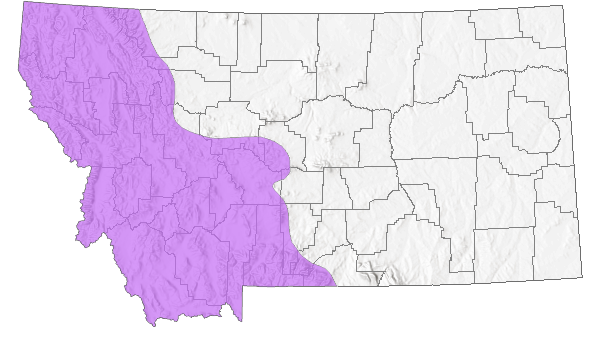
 Native
Native
Range Comments
Lewis’ Monkeyflower can be found in North America from Alaska south to California, Utah and Wyoming (Lesica et al. 2012).
Observations in Montana Natural Heritage Program Database
Number of Observations: 203
(Click on the following maps and charts to see full sized version)
Map Help and Descriptions
Relative Density
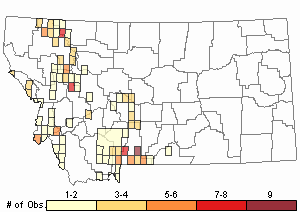
Recency
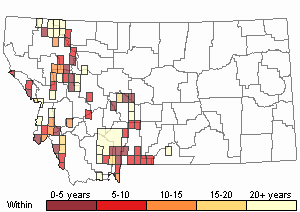
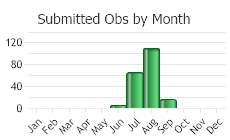
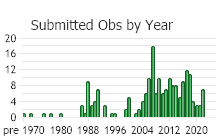
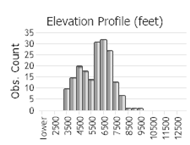 (Observations spanning multiple months or years are excluded from time charts)
(Observations spanning multiple months or years are excluded from time charts)
Habitat
Lewis’ Monkeyflower prefers to grow in wet meadows and along streams from montane to subalpine zones in Montana (Lesica et al. 2012).
National Vegetation Classification System Groups Associated with this Species
Wetland and Riparian
Alpine Riparian and Wetland
Wet Meadow and Marsh
Ecology
POLLINATIONSpecific scent compounds cause differential pollinator attraction in Lewis’ Monkeyflower and Scarlet Monkeyflower (
Mimulus cardinalis) (Byers et al. 2014). This phenomenon is almost entirely (98%) responsible for the reproductive isolation between the two species (Byers et al. 2014). The dominant volatile organic compounds found in Lewis’ Monkeyflower are the three monoterpenes limonene, ocimene, and myrcene which together attract bumble bee-pollinators (Byers et al. 2014). Scarlet Monkeyflower, which produces only limonene, attracts hummingbirds (Byers et al. 2014). Scarlet Monkeyflower occurs in the western U.S., but not in Montana (<https://plants.usda.gov> accessed on May 3, 2020).
Potential and Known Pollinators:
The following animal species have been reported as pollinators of this plant species or its genus where their geographic ranges overlap:
Bombus vagans,
Bombus bifarius,
Bombus centralis,
Bombus flavifrons, and
Bombus pensylvanicus (Thorp et al. 1983, Colla and Dumesh 2010).
ECOLOGICAL TOLERANCE and FUNCTIONSLewis' Monkeyflower grows in the mountains at middle and upper elevations. Plants grow along high elevation streams and runoff channels where it is often abundant and may act as a bank stabilizer (Meinke 1995). Plants are also a primary producer in many montane and subalpine meadows and wetlands (Meinke 1995).
The fitness of Lewis’ Monkeyflower was studied in the Sierra Nevada Mountains of California (Angert et al. 2005). Plants at the center of their elevational range were found to have the greatest average fitness. As populations move farther from this elevation toward their range limits fitness decreases as the species becomes increasingly maladapted. In a transplant experiment individuals planted below their elevational range limits all died within one year and never reached sexual maturity. Population growth rates and the abundance of Lewis’ Monkeyflower were found to be highest at central elevations.
Depending on where an individual is located in the species’ elevational range, leaf energy balance and gas-exchange characteristics of Lewis’ Monkeyflower may vary (Field et al. 1982). Stomatal conductance decreases with increasing water vapor correlation gradient associated with changing elevations (Field et al. 1982). This is a response that is important for avoiding inhibitory water stress and diffusion limitations of photosynthesis.
Reproductive Characteristics
Plants reproduce by seeds and rhizomes.
FLOWERS
The mature flowers of Lewis’ Monkeyflower have a 3 to 5 cm long corolla that is bilabiate and a bearded, 2-ridged, yellow palate (Lesica et al. 2012). The corolla limb is pink-purplish or rose to magenta colored and the tube/palate is yellow with purple-spots. The calyx is 15 to 25 mm long with acute subequal teeth and the pedicels are 2 or more times as long as the calyx.
FRUITS
The mature fruit are ellipsoid capsules, 12 to 16 mm long, and contains many seeds (Lesica et al. 2012).
SEED DISPERSAL
Considering they are most often found along stream margins, the primary mechanism for seed dispersal is flowing water (Meinke 1995). Wind is a secondary mechanism for seed dispersal (Meinke 1995).
Stewardship Responsibility
References
- Literature Cited AboveLegend:
 View Online Publication
View Online Publication Lesica, P., M.T. Lavin, and P.F. Stickney. 2012. Manual of Montana Vascular Plants. Fort Worth, TX: BRIT Press. viii + 771 p.
Lesica, P., M.T. Lavin, and P.F. Stickney. 2012. Manual of Montana Vascular Plants. Fort Worth, TX: BRIT Press. viii + 771 p.
- Additional ReferencesLegend:
 View Online Publication
View Online Publication
Do you know of a citation we're missing? Aho, Ken Andrew. 2006. Alpine and Cliff Ecosystems in the North-Central Rocky Mountains. Ph.D. Dissertation. Bozeman, Montana: Montana State University. 343 p.
Aho, Ken Andrew. 2006. Alpine and Cliff Ecosystems in the North-Central Rocky Mountains. Ph.D. Dissertation. Bozeman, Montana: Montana State University. 343 p. Culver, D.R. 1994. Floristic analysis of the Centennial Region, Montana. M.Sc. Thesis. Montana State University, Bozeman. 199 pp.
Culver, D.R. 1994. Floristic analysis of the Centennial Region, Montana. M.Sc. Thesis. Montana State University, Bozeman. 199 pp. Dale, D. 1973. Effects of trail use under forests in the Madison Range, Montana. M.Sc. Thesis. Bozeman, MT: Montana State University. 96 pp.
Dale, D. 1973. Effects of trail use under forests in the Madison Range, Montana. M.Sc. Thesis. Bozeman, MT: Montana State University. 96 pp. Fultz, J.E. 2005. Effects of shelterwood management on flower-visiting insects and their floral resources. M.Sc. Thesis. Bozeman, MT: Montana State University. 163 p.
Fultz, J.E. 2005. Effects of shelterwood management on flower-visiting insects and their floral resources. M.Sc. Thesis. Bozeman, MT: Montana State University. 163 p. Jones, W. W. 1901. Preliminary flora of Gallatin County. M.S. Thesis. Bozeman, MT: Montana State College. 78 pp.
Jones, W. W. 1901. Preliminary flora of Gallatin County. M.S. Thesis. Bozeman, MT: Montana State College. 78 pp. Lesica, P., M.T. Lavin, and P.F. Stickney. 2022. Manual of Montana Vascular Plants, Second Edition. Fort Worth, TX: BRIT Press. viii + 779 p.
Lesica, P., M.T. Lavin, and P.F. Stickney. 2022. Manual of Montana Vascular Plants, Second Edition. Fort Worth, TX: BRIT Press. viii + 779 p. Tuinstra, K. E. 1967. Vegetation of the floodplains and first terraces of Rock Creek near Red Lodge, Montana. Ph.D dissertation. Montana State University, Bozeman 110 pp.
Tuinstra, K. E. 1967. Vegetation of the floodplains and first terraces of Rock Creek near Red Lodge, Montana. Ph.D dissertation. Montana State University, Bozeman 110 pp. Williams, K.L. 2012. Classification of the grasslands, shrublands, woodlands, forests and alpine vegetation associations of the Custer National Forest portion of the Beartooth Mountains in southcentral Montana. M.Sc. Thesis. Bozeman, MT: Montana State University. 376 p.
Williams, K.L. 2012. Classification of the grasslands, shrublands, woodlands, forests and alpine vegetation associations of the Custer National Forest portion of the Beartooth Mountains in southcentral Montana. M.Sc. Thesis. Bozeman, MT: Montana State University. 376 p.
- Web Search Engines for Articles on "Lewis' Monkeyflower"





